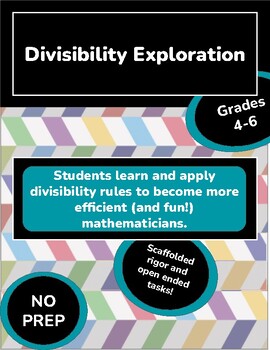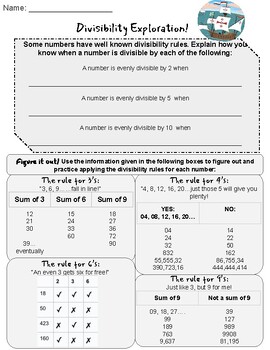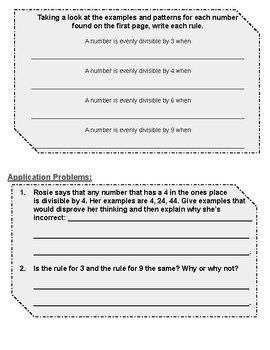Leveled Divisibility Exploration
MrsHannaMath
5 Followers
Grade Levels
4th - 6th
Subjects
Resource Type
Standards
CCSS4.NBT.B.6
CCSS5.NBT.B.6
CCSS4.OA.B.4
CCSS6.NS.B.2
CCSSMP1
Formats Included
- PDF
Pages
15 pages
MrsHannaMath
5 Followers
Description
In this packet, students look for patterns and use logical reasoning to figure out and apply divisibility rules. The tasks become more complex and challenging as the students progress through the pages, making it easily leveled.
This could be a long-term extension/enrichment project for a small group to work on during center time, or a deep-dive for the whole class to tackle in a few days.
Most questions are open-ended or have multiple correct answers, allowing for students to explore what makes sense to them and encouraging perseverance through a "productive struggle."
Total Pages
15 pages
Answer Key
Included
Teaching Duration
1 Week
Report this resource to TPT
Reported resources will be reviewed by our team. Report this resource to let us know if this resource violates TPT’s content guidelines.
Standards
to see state-specific standards (only available in the US).
CCSS4.NBT.B.6
Find whole-number quotients and remainders with up to four-digit dividends and one-digit divisors, using strategies based on place value, the properties of operations, and/or the relationship between multiplication and division. Illustrate and explain the calculation by using equations, rectangular arrays, and/or area models.
CCSS5.NBT.B.6
Find whole-number quotients of whole numbers with up to four-digit dividends and two-digit divisors, using strategies based on place value, the properties of operations, and/or the relationship between multiplication and division. Illustrate and explain the calculation by using equations, rectangular arrays, and/or area models.
CCSS4.OA.B.4
Find all factor pairs for a whole number in the range 1-100. Recognize that a whole number is a multiple of each of its factors. Determine whether a given whole number in the range 1-100 is a multiple of a given one-digit number. Determine whether a given whole number in the range 1-100 is prime or composite.
CCSS6.NS.B.2
Fluently divide multi-digit numbers using the standard algorithm.
CCSSMP1
Make sense of problems and persevere in solving them. Mathematically proficient students start by explaining to themselves the meaning of a problem and looking for entry points to its solution. They analyze givens, constraints, relationships, and goals. They make conjectures about the form and meaning of the solution and plan a solution pathway rather than simply jumping into a solution attempt. They consider analogous problems, and try special cases and simpler forms of the original problem in order to gain insight into its solution. They monitor and evaluate their progress and change course if necessary. Older students might, depending on the context of the problem, transform algebraic expressions or change the viewing window on their graphing calculator to get the information they need. Mathematically proficient students can explain correspondences between equations, verbal descriptions, tables, and graphs or draw diagrams of important features and relationships, graph data, and search for regularity or trends. Younger students might rely on using concrete objects or pictures to help conceptualize and solve a problem. Mathematically proficient students check their answers to problems using a different method, and they continually ask themselves, "Does this make sense?" They can understand the approaches of others to solving complex problems and identify correspondences between different approaches.





